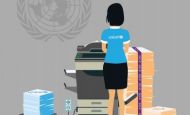Save the Children’s Misleading Report on Detention of Palestinians
On Thursday, October 29, 2020, Save the Children will release a report on “the impact of the Israeli military detention system on Palestinian children.” NGO Monitor has obtained and reviewed an advance copy of this publication. Our analysis shows that Save the Children has produced an inaccurate report, which cannot support the (predetermined) legal and policy conclusions drawn. The numerous highly emotive illustrations present a very politicized narrative that is clearly designed to demonize Israelis, not to protect minors. The answer to violence by Palestinian minors, including acts of terrorism and murder, is to address the incitement behind such actions, and not to absolve them of accountability, as proposed in the report.
In addition, we note that the page cover notes the report was “co-funded by the European Union” and features the EU logo. The latest available data from the EU (through 2019) does not show any projects involving Save the Children in recent years; however, there may be funds from 2020 that have not yet been made public. The fundamental flaws in this publication suggest that the EU should focus on educating Palestinian children to not be involved in violent crime, in place of more advocacy to demonize Israel.
NGO Monitor’s analysis of Save the Children’s report shows:
- False and outdated “context”: The section purporting to provide an “Overview of the Israeli military detention system” is based on highly misleading and outdated assessments of how Israeli military courts deal with Palestinian children suspected of involvement with terrorism and other crimes. It fails to account for significant changes, with an emphasis on treatment of minors, that Israel has instituted over the past five years, in cooperation and consultation with international experts. Most notably, Save the Children repeats the thoroughly discredited claims from a 2013 report issued under UNICEF’s imprimatur (see “The Origins of ‘No Way to Treat a Child’: Analyzing UNICEF’s Report on Palestinian Minors” for an extensive discussion of UNICEF’s distortions that undermine Save the Children’s claims.)
- Grossly understating levels of violence and terror involving Palestinian minors: The Israeli military justice system only deals with minors suspected of violent crimes such as murder, attempted murder, and severe assault. Many of the “children” are older teens (16-18), incited by terror groups and the Palestinian Authority, and involved in such violent acts. This vital context is left conspicuously unstated by Save the Children. Save the Children also claims that is not seeking to downplay “the potential seriousness of” stone throwing, and then does exactly that. Instead of highlighting the deaths and significant injuries that have occurred due to stone throwing, Save the Children refers to an old study (2012) to argue that “the prevalence and severity of physical injury resulting from stone throwing is very low” and that “This should be noted when considering the proportionality of the treatment that children endure throughout their detention experience
- Erasing Palestinian incitement: Save the Children completely ignores the most important factors causing violence by Palestinian minors: incitement from Palestinian media, textbooks, and political and religious leaders, as well as a culture of dehumanization, violence, and anti-normalization toward Israelis. The report briefly mentions that “The vast majority of children we consulted (87%) reported feeling like they are a hero for the Palestinian cause” and “The phenomenon of ‘heroisation’ within Palestinian society (and occasionally, the wider international community).” However, this is only discussed in the context of the children’s psychological experience; this incitement is not considered as a contributing factor to the culture of violence that imperils children even long before they are detained. In this respect, it is essential to note that Save the Children itself has partnered with Palestinian institutions that incite children to engage in violence. In 2018, Save the Children and the Swedish government conducted a project with the Islamic Jihad-linked Dar al Huda kindergarten in Gaza. In 2018, Dar al Huda’s graduation ceremony featured the mock killing and kidnapping of Israelis by children dressed as combatants. The simulation included sophisticated equipment such as drones, body cameras, military fatigues, body armor, and sniper camouflage. Children wore Islamic Jihad headbands.
- Confused “International Legal Context”: Regardless of the opinions of Save the Children, under international law, Israel is required try Palestinian minors in military courts. To use civilian courts to try Palestinian minors who commit violent crimes, Israel would have to annex the West Bank – a move decried by Save the Children as “illegal,” “a fatal blow to Palestinian two-state solution,” and “catastrophic for many Palestinian children.” The answer to violence by Palestinian minors, including acts of terrorism and murder, is not to erase the victims of these attacks or absolve the minors of accountability, as proposed by Save the Children: “Save the Children believes that no child should be prosecuted in a military court.”
- Statistical insignificance and lack of verification: Although presented as a research report, the authors acknowledge that, “Save the Children recognises that it is not a statistically significant or representative sample. As the report intentionally presents children’s experience from their own perspective, it is also important to note that incidents they mention have not been independently verified by Save the Children” (emphases added). Unsurprisingly, then, “Most of the children consulted for this report maintain their innocence.”
- Emotions, not factual analysis: All the above demonstrates that Save the Children has produced an emotive report, based on statements from involved parties (the children, Palestinian government officials, anti-Israel NGOs). This is highlighted by the drawings presented throughout the publication. Even if it provided an accurate snapshot of what former Palestinian child detainees feel, it would still be insufficient to draw the predetermined, and absurd, legal and policy conclusions.


